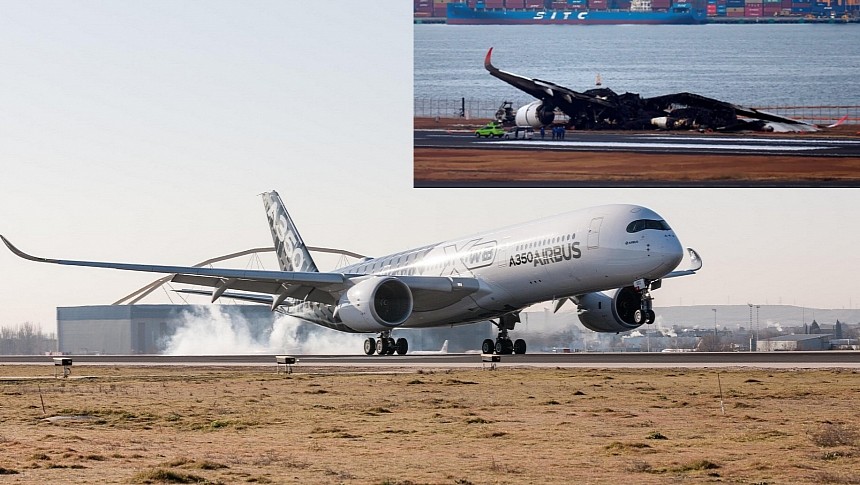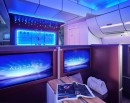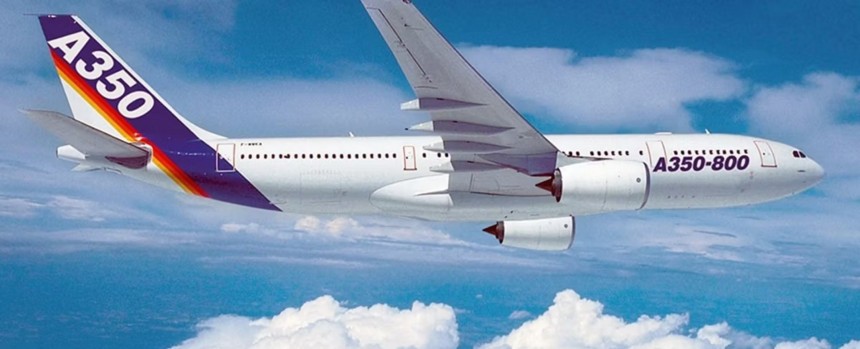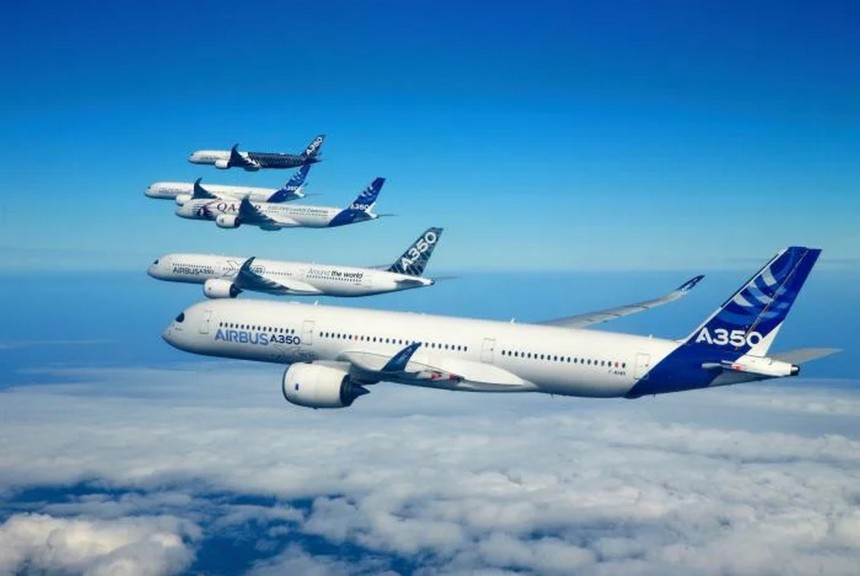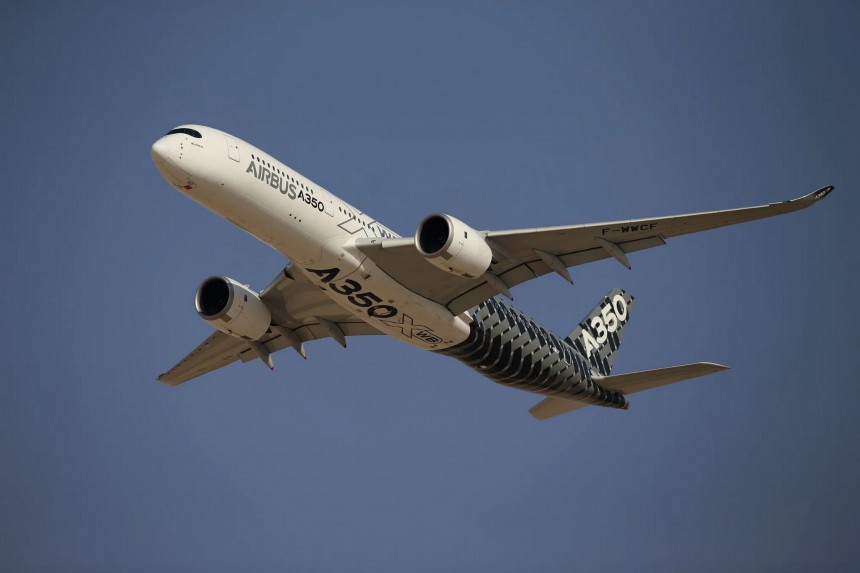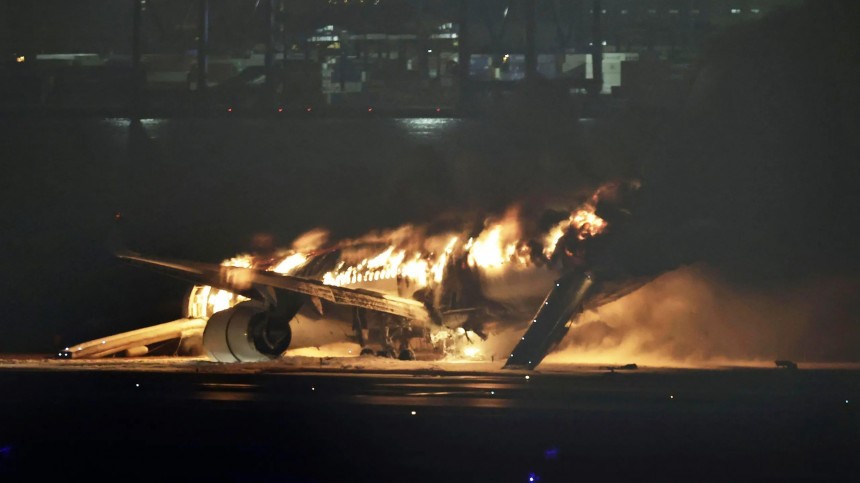We're often told that aviation is safer nowadays than any other form of motorized transportation. In no uncertain terms, you're more likely to harm yourself buckled into a passenger car than you are strapped into a passenger airliner. It might be easy to pass this off as hyperbole, nothing more than a successful PR campaign like so many bold claims of history. But as a genuine, real-world testament about the safety of modern airliners, the Airbus A350 just delivered an impact statement.
At least, that's a common sentiment after a Japan Airlines A350 collided with a Japanese Coast Guard De Havilland Canada Dash 8 utility plane after landing at Tokyo's Haneda Airport the day following New Year's Day 2024. Though five crew aboard the Dash 8 lost their lives, not a single soul aboard Japan Airlines Flight 516, including 12 crew and 367 passengers, was killed. Even as a post-crash fire threatened all onboard Flight 516, the A350's suite of modern safety features warded off the worst effects of the spreading blaze long enough for first responders to save all aboard.
In many ways, the chain of events that transpired during that fateful accident began with decades of advancements in aeronautical safety, thanks in no small part to the work at Airbus. Since the first Airbus passenger airliner, the wide-body, twin-jet A300, entered service in 1974, Airbus has embarked on a quest to fill every conceivable sector of the civil airliner space. The core nucleus of this Airbus aircraft fleet is primarily developed directly from the A300, or at least with its design principles at heart.
Throughout it all, an emphasis on increased safety was a guiding design principle. One such development of the A300 was the A330. First flown in 1992, with its service deployment in 1994, the A330, with seating for between 246 and 300, depending on the variant, was Airbus' attempt to bring the A300's framework into the 21st century. Over 1,500 A330 variants have been manufactured since 1992, a production run of over 30 years and counting.
With the exception of the narrow-body A320, the A330 is one of the most successful aircraft in the half-century of Airbus' operations. The A330, in no small part, helped destroy an effective monopoly of the global airliner space by American manufacturers, most often Boeing. But in fact, it was because of plans set in place by Airbus' rivals at Boeing which became the impetus behind the design of a new wide-body, twin-jet from Airbus. Safe to say, things didn't always go according to plans.
For the next decade and a half following the A330's operational deployment, the jet was in a near-constant asymmetric sales matchup between itself and Boeing's premiere twin-engine, wide-body jetliner, the 777, deployed only 18 months or so after the A330's first commercial flight. Though larger and with a higher seating capacity than the A330 and the 777, all roads in the mid-size, wide-body jetliner space lead through these two airframes in the '90s and 2000s.
That was, at least, until Boeing unveiled a new strategy to attack the A330's market share from above and below. As 777s, as well as the 767 to an extent, competed for the same contracts as A330s from above in terms of size, the announcement of the Boeing 7E7 project in 2003, later dubbed the 787 Dreamliner, was sized within seven feet of the A330-200 in length. In no uncertain terms, Boeing was coming for the A330's lunch money. At least, one would assume this was the line of thinking. But at least at first, Airbus was unimpressed with its rival's showings.
The prevailing belief of Airbus' board of directors at the time was that the 7E7 was a mere reactionary counter to what was believed to be a superior European airframe. One which global airlines wouldn't be eager to forgo at such an early juncture. But Airbus was wrong in their assumption, as prominent A330 operators, most notably Air France, which later operated both the 787 and A330 simultaneously, as well as Singapore Airlines, demanded Airbus develop a direct counter to Boeing's newest twin-jet.
In 2004, then under the directorship of CEO Noël Forgeard, who'd yet to resign in discrace following an insider trading scandal just yet, Airbus began a mad scramble to provide its most loyal A330 customers with a new wide-body, twin-jet platform more suited to compete with the 787 Dreamliner. A story first reported in North America by The Seattle Times, Boeing's hometown news publication, detailed Airbus's drive to answer the call of its operating partners by modifying the existing architecture of the A330-200. In the piece, Boeing personnel didn't hold back their criticism.
The most scathing quote came from Boeing's then-Vice President of Airliner Marketing. "We find it interesting that Airbus is spending so much time talking about an airplane they say they are not worried about," said Baseler through an e-mail thread with The Seattle Times in preparation for the 2004 article. "Now it appears they may be trying to respond to a game-changing aircraft with a 'lite' version of a 15-year-old design." But to Airbus' credit, the proposal did at least seem viable.
By eliminating as much weight as possible with the novel, cutting-edge construction materials, a design initiative dubbed the A330-200Lite was hoped to give Airbus' critics in the airline business the 787 competitors they desired. Ultimately, plans for the A330-200Lite project fell through, and Airbus decided to supplement existing fleets of A330s with the upgraded A330neo. Even so, Airbus finalized the design for a 300-seater, wide-body, twin-jet airliner and dubbed it the A350.
Under the original scheme, the A330-derived A350 would have split the difference between the Boeing 777 and 787 in a way that was hoped would lure customers away from investing in two Boeing airframes instead of just one from Airbus. But as it turned out, the original A350 design's origins in an older design worked against it in the eyes of critics. The famous airliner mogul Steven F. Udvar-Hazy even went to the Seattle Times bemoaning Airbus for its lack of vision and the obvious knee-jerk nature of the A350 program to that point.
In no uncertain terms, Udvar-Hazy, a billionaire who escaped Communist Budapest as a youth and built a passenger airliner brokerage firm into one of the most lucrative enterprises for a single individual in aeronautical history, dammed Airbus' plan as "a Band-aid reaction to the 787," in his own words. This sentiment greatly shook the nerves of the engineers at Airbus, and the original A350 platform was scrapped entirely in favor of a wholly bespoke airframe. At this pivotal stage, the A350 truly differentiated itself from every other wide-body airliner in the sector.
Not only would the A350 now be an aircraft with a plethora of modern build materials like titanium, space-age carbon composite alloys, and lightweight carbon fiber-reinforced polymers, but it'd also benefit from the latest advancements in aeronautical safety. After a comprehensive redesign with plans for a 440-seat A350-900 and 480-seat A350-1000 was completed, its triumphant first flight on Jue 14th, 2013, proved a commercial airliner really could designed twice and still make it off the drawing board.
With dimensions of 66.8 meters (219.2 ft) and 73.79 meters (242.1 ft) long for the A350-900 and 1000, respectively, with a 64.75-meter (212.1-ft) wingspan across both civil variants, the A350's twin Rolls-Royce Trent XWB high-bypass turbofan engines made for one of the smoothest flying twin-jets to take its first flight in the 2010s. Airbus even commissioned BMW, of all people, to design a fully custom interior for the A350, complete with smart lighting touches and extra attention paid to efficient baggage storage.
Meanwhile, the A350's cockpit sported a suite of new safety features via its beefed-up flight management system programmed to provide vital information in the event of any number of critical situations. All these qualities and all this history came to a head on January 2nd, 2024, when an Airbus A350-900 collided with a Japanese Coast Guard utility aircraft on landing. It then skidded over a kilometer down Haneda Airport's runway 34R to a stop. Though the cabin filled with smoke and a fire broke out on the left-hand engine, the A350's rugged, largely composite airframe withstood the flames until a swarm of over 100 fire trucks and support vehicles could mount a rescue.
By the grace of modern aerospace technology and a healthy dose of heroism from Haneda Airport's accident response team, every last person who boarded Japan Air Flight 516 at New Chitose Airport in Sapporo left the battered plane with their lives. Only after all crew and passengers aboard evacuated did the vicious flames fully consume the aircraft, reducing it to little more than cinders. Had an aircraft only 25 years older been involved in a similar accident, one shudders to imagine how things could've turned exponentially more tragic than it already was.
It's for this reason that all aboard Flight 516, and even the public at large who fly on their aircraft, owe the engineering team at Airbus our thanks. It would be insane to call what's by all accounts still a tragic accident to be a positive PR move. But with so many lives saved now to the A350's credit, it's difficult not to sing its praises. At the very least, it lends the notion of airlines being the safest way to travel more credence than ever before.
In many ways, the chain of events that transpired during that fateful accident began with decades of advancements in aeronautical safety, thanks in no small part to the work at Airbus. Since the first Airbus passenger airliner, the wide-body, twin-jet A300, entered service in 1974, Airbus has embarked on a quest to fill every conceivable sector of the civil airliner space. The core nucleus of this Airbus aircraft fleet is primarily developed directly from the A300, or at least with its design principles at heart.
Throughout it all, an emphasis on increased safety was a guiding design principle. One such development of the A300 was the A330. First flown in 1992, with its service deployment in 1994, the A330, with seating for between 246 and 300, depending on the variant, was Airbus' attempt to bring the A300's framework into the 21st century. Over 1,500 A330 variants have been manufactured since 1992, a production run of over 30 years and counting.
With the exception of the narrow-body A320, the A330 is one of the most successful aircraft in the half-century of Airbus' operations. The A330, in no small part, helped destroy an effective monopoly of the global airliner space by American manufacturers, most often Boeing. But in fact, it was because of plans set in place by Airbus' rivals at Boeing which became the impetus behind the design of a new wide-body, twin-jet from Airbus. Safe to say, things didn't always go according to plans.
That was, at least, until Boeing unveiled a new strategy to attack the A330's market share from above and below. As 777s, as well as the 767 to an extent, competed for the same contracts as A330s from above in terms of size, the announcement of the Boeing 7E7 project in 2003, later dubbed the 787 Dreamliner, was sized within seven feet of the A330-200 in length. In no uncertain terms, Boeing was coming for the A330's lunch money. At least, one would assume this was the line of thinking. But at least at first, Airbus was unimpressed with its rival's showings.
The prevailing belief of Airbus' board of directors at the time was that the 7E7 was a mere reactionary counter to what was believed to be a superior European airframe. One which global airlines wouldn't be eager to forgo at such an early juncture. But Airbus was wrong in their assumption, as prominent A330 operators, most notably Air France, which later operated both the 787 and A330 simultaneously, as well as Singapore Airlines, demanded Airbus develop a direct counter to Boeing's newest twin-jet.
In 2004, then under the directorship of CEO Noël Forgeard, who'd yet to resign in discrace following an insider trading scandal just yet, Airbus began a mad scramble to provide its most loyal A330 customers with a new wide-body, twin-jet platform more suited to compete with the 787 Dreamliner. A story first reported in North America by The Seattle Times, Boeing's hometown news publication, detailed Airbus's drive to answer the call of its operating partners by modifying the existing architecture of the A330-200. In the piece, Boeing personnel didn't hold back their criticism.
By eliminating as much weight as possible with the novel, cutting-edge construction materials, a design initiative dubbed the A330-200Lite was hoped to give Airbus' critics in the airline business the 787 competitors they desired. Ultimately, plans for the A330-200Lite project fell through, and Airbus decided to supplement existing fleets of A330s with the upgraded A330neo. Even so, Airbus finalized the design for a 300-seater, wide-body, twin-jet airliner and dubbed it the A350.
Under the original scheme, the A330-derived A350 would have split the difference between the Boeing 777 and 787 in a way that was hoped would lure customers away from investing in two Boeing airframes instead of just one from Airbus. But as it turned out, the original A350 design's origins in an older design worked against it in the eyes of critics. The famous airliner mogul Steven F. Udvar-Hazy even went to the Seattle Times bemoaning Airbus for its lack of vision and the obvious knee-jerk nature of the A350 program to that point.
In no uncertain terms, Udvar-Hazy, a billionaire who escaped Communist Budapest as a youth and built a passenger airliner brokerage firm into one of the most lucrative enterprises for a single individual in aeronautical history, dammed Airbus' plan as "a Band-aid reaction to the 787," in his own words. This sentiment greatly shook the nerves of the engineers at Airbus, and the original A350 platform was scrapped entirely in favor of a wholly bespoke airframe. At this pivotal stage, the A350 truly differentiated itself from every other wide-body airliner in the sector.
With dimensions of 66.8 meters (219.2 ft) and 73.79 meters (242.1 ft) long for the A350-900 and 1000, respectively, with a 64.75-meter (212.1-ft) wingspan across both civil variants, the A350's twin Rolls-Royce Trent XWB high-bypass turbofan engines made for one of the smoothest flying twin-jets to take its first flight in the 2010s. Airbus even commissioned BMW, of all people, to design a fully custom interior for the A350, complete with smart lighting touches and extra attention paid to efficient baggage storage.
Meanwhile, the A350's cockpit sported a suite of new safety features via its beefed-up flight management system programmed to provide vital information in the event of any number of critical situations. All these qualities and all this history came to a head on January 2nd, 2024, when an Airbus A350-900 collided with a Japanese Coast Guard utility aircraft on landing. It then skidded over a kilometer down Haneda Airport's runway 34R to a stop. Though the cabin filled with smoke and a fire broke out on the left-hand engine, the A350's rugged, largely composite airframe withstood the flames until a swarm of over 100 fire trucks and support vehicles could mount a rescue.
By the grace of modern aerospace technology and a healthy dose of heroism from Haneda Airport's accident response team, every last person who boarded Japan Air Flight 516 at New Chitose Airport in Sapporo left the battered plane with their lives. Only after all crew and passengers aboard evacuated did the vicious flames fully consume the aircraft, reducing it to little more than cinders. Had an aircraft only 25 years older been involved in a similar accident, one shudders to imagine how things could've turned exponentially more tragic than it already was.
